Anterior Cervical Fusion
What is a Disc?
The spine is a column that is made of up bones, discs and ligaments. The blocks of bone (or vertebrae) provide the anterior support and structure of the spine. The discs are in between the bones and act like a “shock absorber” between the vertebrae. The discs also contribute to the flexibility and mobility of the spinal column. The discs are made up of two parts:
- The inner portion of the disc is a jelly-like material and is called the nucleus pulposus and
- The outer part, called the annulus fibrosis of the disc, is stronger and more fibrous. The annulus fibrosis surrounds and supports the inner jelly material.
Disc material is mainly composed of water and other proteins. As a normal part of aging, the water content gradually reduces. This can cause the disc to flatten out and even develop tears or cracks throughout the annulus fibrosis. These discs are often referred to as “degenerative” discs and may or may not cause pain.
In the case of a degenerative disc, the inner jelly material (the nucleus pulposus) can bulge out and press up against the annulus fibrosis. This can stimulate the pain receptors causing pain to occur. The cracks or tears that develop within the annulus fibrosis can also become a source of pain. Finally, the inner nucleus can also come out through the cracks in the annulus and compress nerves or spinal cord, a condition that may cause weakness, pain, pins and needles or numbness, and may require surgery.
Current Treatment Options for Prolapsed Discs
Non-surgical options for people with disc protrusions in the neck include rest, heat, pain medications and physiotherapy. When non-surgical treatment options fail, surgery is often the next step. This usually means spinal fusion surgery. Neck pain with compression of the nerves in the neck or spinal cord is a common condition that affects the spine and may require surgery. If only nerves are compressed, with symptoms in one arm, a period of conservative management is instituted and if this fails surgery is contemplated. Early surgery is performed if there is severe weakness or pain that cannot be effectively controlled with available analgesia. If the spinal cord is being compressed, surgery to decompress the spinal cord is usually recommended. This compression can be caused by bulging disc or bony spurs.
Surgery on the spinal cord is performed either from the back of the neck (laminectomy) or through the front of the neck (cervical discectomy or vertebrectomy). If the compression of the spinal cord is from the front, then the decompression must be done from the front (anterior decompression). Typically if the entire disc is removed, a wedge of bone is taken from the hip and put into its place, possibly with a plate and screws to hold it into place (see below). This is commonly referred to as an anterior cervical decompression and fusion.
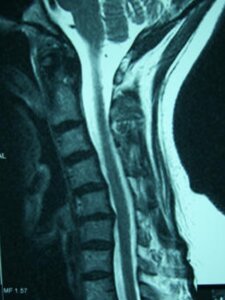
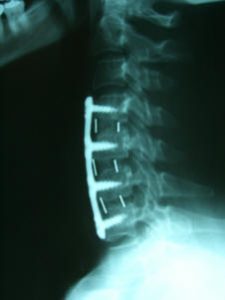
Above left): MRI scan of the cervical spine showing a two discs pushing on the spinal cord with a smaller disc bulge at the top.
(Above middle): A postoperative x-ray of a typical anterior discectomy and fusion procedure, in this case performed at three levels.
A plastic cage (made of PEEK) is filled with an enhancer of fusion and placed into the disc space. There are markers in front and behind the cage (appear bright white). A Plate holds it all together. Note that the kyphosis (sagging) of the spine is fixed.
(Above right): A postoperative MRI on the patient shown to the left. The discs have been removed, and a complete decompression of the spinal cord has been effected.
This is a common operation and whilst it takes pressure off the spinal cord, it necessitates that at least 2 of 7 bones in the neck are fused. This does reduce some of the movement in the neck, especially, looking upwards at the ceiling and looking over ones shoulder but patients typically do not notice it unless many levels are fused and in most cases, improving neck pain improves neck movement more than the fusion takes away. Typically after this surgery, the patients were a neck brace for 6 weeks.
The problem with fusing bones in the neck are that adjacent levels in the neck are placed under more strain. This has increased “wear and tear” at the surrounding disc space levels has been termed “adjacent segment stenosis”. We now know that if 10 people have a single level fusion, at 10 years 3 have had to have another operation for narrowing at the next level either above or below. This is less likely with multilevel fusions. Secondly, the bone does not always heal or “fuse” correctly. In fact, the overall success rates for these procedures range from 48% to 89%.
Definition
Anterior cervical decompression and fusion is removal of disc and/or bone through an approach through the front of the neck and then filling the cavity formed with bone from the hip and possibly placing screws and plates to hold the whole construct into place. The typical patient presents with either arm symptoms such as pain, weakness, numbness or pins and needles, or else symptoms and signs of spinal cord dysfunction, termed myelopathy. Myelopathy can manifest in a number of ways, including generalized stiffness, difficulty walking, loss of fine motor control in the hands etc. Compression of nerves or spinal cord is typically caused by disc material or bony spurs.
A disc protrusion per se may not cause symptoms. If the annulus is acutely torn, neck pain may result, but the management is usually not operative. If the disc pushes on a nerve, as shown in the previous scans, then symptoms down one or occasionally both arms may result. The symptoms can include pain, numbness, “pins and needles”, and weakness.
Anatomy
The anatomy of a typical intervertebral disc as shown below:
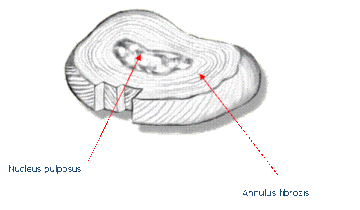
(Below): The intervertebral disc lies in front of the spinal nerves and is situated between the vertebral bodies. It carries 80% of the load through that level and is the shock absorber for the spine. The lowermost discs (C56 and C67) are most prone to wear and tear and potential rupture.
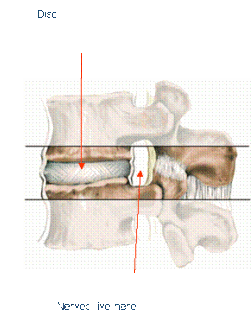
Note that there is an outer shell, called the annulus fibrosis and an inner core called the nucleus pulposus. The annulus is the consistency of a pencil eraser, whereas the nucleus is gel-like and, as we get older, dehydrates and becomes like crabmeat. The discs act as shock absorbers and flexing the spine loads the disc. A tear in the outer annulus can consequently cause severe back pain. Patients will often be able to remember a time when they lifted poorly or twisted their back and had severe back pain prior to getting the leg pain. Once an annular tear occurs, it may heal, or it may allow nucleus to come out of the centre of the disc, into the spinal canal, where it may compress nerves. This is usually called one of a number of terms, including “disc prolapse”, “ruptured disc”, “slipped disc”, “extruded disc” etc. All these terms essentially mean the same thing. Once nerves are compressed, surgery may be complicated. It is important to know that the prolapsed disc cannot be pushed back into place and nothing but time will heal the annular tear. Thus, in general, any surgery is aimed at improving the leg pain, not the back pain.
Reason For Operation
Cervical disc protrusions are not usually operated upon early, but there are some clear situations when a surgeon may recommend early surgery. If there is evidence of severe weakness, early surgery may be offered. If the pain in the arm is so severe that narcotic analgesia is not controlling the pain, early surgery may again be an option. If there is spinal cord compression typically early surgery is also offered.
If a patient has pain, but it is not too severe, then typically conservative management is initiated. It must be remembered that the vast proportion of patients will settle with time and as long as improvements are noted at 6 weeks, there is minimal or no weakness, and the pain is not excruciating and is livable with oral analgesia, then waiting and continuing with conservative therapy is a good option.
If weakness occurs and is not improving, surgery is usually offered. Similarly, if symptoms are not improving at 6 weeks then surgery is an option.
In most cases, when managing arm leg pain, surgery is a treatment option that speeds up the rate of recovery, remembering that most cases will get better by themselves. Again, specific recommendations are tailored to the patient. In the vast number of cases, the goal is control of pain, and an intervention that achieves this and is less invasive than surgery is a reasonable option.
The main reason this form of surgery is performed is to try and reduce the risk of deterioration in spinal cord function. At the extreme end, bad myelopathy patients are wheelchair bound. Coupled with this, even patients with little in the way of symptoms are more at risk of spinal cord injury. This is because the space for the spinal cord is reduced and an accident as trivial as a minor car accident can transiently narrow this space via ligamentous buckling, injuring the cord. Consequently, this surgery is primarily performed as a prophylactic procedure to stop deterioration in the future.
Technique
The operation is preformed under general anesthesia and as shown above a cut is made in front of the neck. The food and wind pipe are shifted over and the operation is performed between these and the blood vessels to the brain. The disc is removed in entirety, and after the spinal cord and nerves have pressure from them removed, graft is placed into the cavity.
This can typically be:
- Bone from the hip (autograft). Painful
- Bone bank bone (allograft). From cadavers with a small risk of disease transmission
- A Plastic cage made of PEEK, filled with bone graft substitute or BMP, to enhance fusion (much more common now).
- A plate and screws may be placed over this to keep the graft in place. The operation takes 1-3 hours and after surgery a collar is in place for 6 weeks.
A cervical plate is shown below:
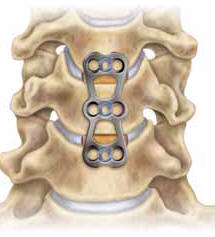
Risks
The greatest risk is injury to one or more nerves and this is typically 1-2%. There is a risk of death, quadriplegia or severe spinal cord injury. The risks of infection, bleeding etc. etc. are similar to those for a laminectomy as are the risks of general complications. There are other risks particular to this operation. Temporary or permanent swallowing problems or hoarseness of voice can occur. They are common temporarily but not so permanently The hip graft site is more likely to get infected. The combined risks are about 5-10%.
The small but real risks from surgery are the reason why all patients with disc protrusions do not immediately have surgery.
Expectations
In uncomplicated cases the likelihood of good/excellent relief of arm pain is 80-90%. Numbness is slow to recovery and may persist. Weakness also may take 6-12 weeks to return to normal. Pins and needles usually starts to improve immediately.
If the surgery was for myelopathy, as a rule:
- 40% get better
- 40% stay the same
- 20% continue to deteriorate
Recovery
Some pain on swallowing is not uncommon. Some pain at the back of the neck is not uncommon and is due to stretching. Most patients spend 1-2 nights in hospital and mobilize and go home the next day. A collar is worn for 4-6 weeks. At this time repeat x-rays are done, which if satisfactory, lead to discontinuation of the collar.
Non-Surgical Options
Despite the length discussion about surgery, most patients get better without surgery.
Conservative therapy comprises
- Analgesia with NSAIDs (e.g. Mobic, Voltaren or Celebrex)
- Analgesia with other medications such as Tramadol
- Avoidance of neck flexion at computer screens etc. for long periods
- Physiotherapy (traction may help)
- Hydrotherapy (particularly if back pain is a problem)
- Cessation of smoking
- Possibly acupuncture
- Hydrotherapy (particularly if back pain is a problem)
- Perineural steroid and local anesthetic injections
This is not the case for myelopathy secondary to spinal cord compression, in which there are no conservative options except observation (which we try and avoid) or surgery.
Other Points
Anterior cervical surgery is being supplanted in some cases by artificial disc surgery. It still plays a role in trauma, deformity and in the management of older patients with cervical disc disease.
You may read about artificial cervical discs. There are clear reasons for not putting in artificial disc and doing a fusion instead.
